Electricity equipment for storage and use by feeding solar energy
General
Since the founding of the company SEP Sun Energy Power UG now SEP Sun Energy Power GmbH in 2010, we have been busy building solar systems in various designs.
Through this activity we have noticed that there are two important problems in the world:
clean drinking water
and
energy (electricity)
There are light and sun all over the world.
for this reason, we have considered how we can use solar energy sensibly.
We have succeeded through this
Power supply for daily needs.
Our device, which we have developed, can be used wherever it is needed, whether or not there is power supply already.
Originally, it has been developed for those countries that have light and sun, but no electricity or infrastructure with the appropriate network.
Meanwhile, we can also integrate our unit into the power supply of the house.
Our units have a different size and can be supplied in a kit, for example like at IKEA.
For us not to imaginable a life without electricity!
What would we do without energy?
- no household without electricity
- no industrialization without stom
Market
According to many information from the Internet, a huge market for such devices is available worldwide.
In countries such as Peru, there will be no electricity in certain areas over the next 60 years.
In Burkina Faso, 92% of the population has no electricity.
Even in countries like Sweden, there is not electricity everywhere, for example on the many small islands.
Certainly there are power units which are powered by fuel and these generate electricity but you always need the necessary money.
Nobody thinks about CO2 emissions or
on climate change.
The Congo has, for example, a modern nuclear power plant, but no functioning power line to bring the energy to the end customer.
Development
As already mentioned, our energy storage unit was designed as a 2 kW unit because it was originally designed for those countries that do not have electricity and no infrastructure for a power grid.
In the meantime, we have noticed that there is a great demand for our system even in countries that already have electricity.
For this reason, we decided to develop the device further without leaving the system of the kit.
Advantages of the kit:
- we do not supply a complete device
- We only supply parts by customs
- We only guarantee the parts delivered by us
For our customers:
- You can build your own infrastructure in each country
- a service network can be established for the annual inspections
- our customers can build a mounting system for photovoltaic plants
- Jobs are created
- the development can begin with everything for which energy is needed
As already mentioned, our devices are included in a standard model and differ only in their performance.
The basic dimensions of the large unit are: the small unit are:
Height 84 cm 60 cm
Width 60 cm 45 cm
Depth 60 cm 45 cm
The energy production during the day depends on the available solar hours in the respective countries.
We expect about 7.2 hours of sunshine every day.
The storage for the night depends on the battery sizes and the number of batteries.
The size of the plant depends on the amount of electricity the customer needs daily and can be taken from the plant every hour.
Expansion options
As shown in the section Development, we can adjust the size according to the customer’s requirements.
Therefore it is possible without difficulty to carry out retrofits when the energy requirement increases.
These retrofits are possible at any time in the case of the solar modules as well as in the energy storage units as well as the charger controllers and the inverter.
By means of a 12 volt system, we also have the possibility to carry out cascading and to install an even larger installation.
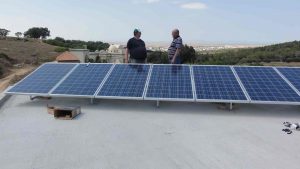 Photovoltaic modules including subconstruction on a flat roof
Photovoltaic modules including subconstruction on a flat roof
Form example: H = 60 cm B = 45 cm T = 45 cm
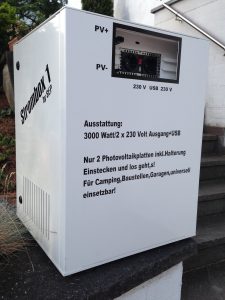
Power unit with 1.5 to 3 KW per hour use and a storage possibility of 1.2 to 2.8 KW
Example Calculation:
2 modules x 265 watts = 0.53 KW
Charger Regulator: 40 AP x 12 Volt = 0.48 KW
0.48 KW x 7.2 sun hours = 3.46 KW
Annual output = 1.262,00 KW
Form example: H = 84 cm B = 60 cm T = 60 cm
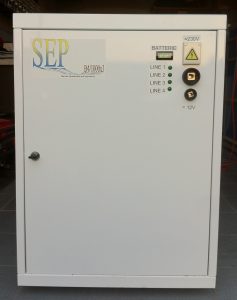 Power unit with 4 KW per hour usage and a memory for 12 KW, as well as 4 lines to the photovoltaic modules.
Power unit with 4 KW per hour usage and a memory for 12 KW, as well as 4 lines to the photovoltaic modules.
- 230 Volt AC connection
- Connection for 12 Volt DC
- Connections for the photovoltaic modules
- 230 Volt AC connection
- Connection for earthing the device
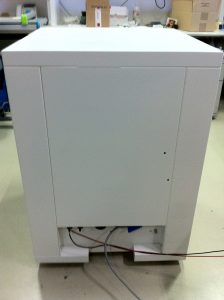
Example Calculation:
4 Modules x 265 watts = 1.06 KW
Loaderegler 1000 Watt x 3 = 3,00 KW
Memory = 12,00 KW
For a full use, 12 modules of 265 watts = 3.18 kW per hour can be produced. At an average of 7.2 sun hours per day, the 22.80 KW.
Thus 10.80 KW for the daily requirement and 12.00 KW for the night supply.
The annual output is 8.322,00 KW.
Various application possibilities for the operation of various devices and machines with a connection of 230 Volt alternating current.
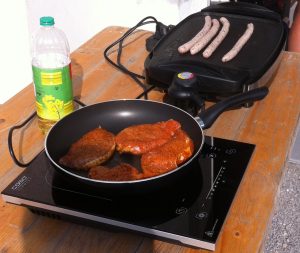 cooking plates and electric grill
cooking plates and electric grill
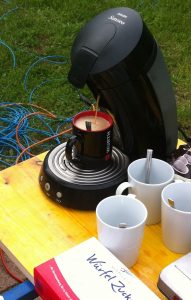
coffee machine
stones cut with a flex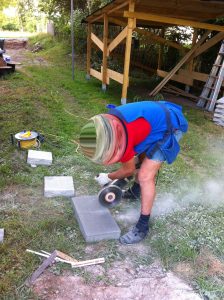
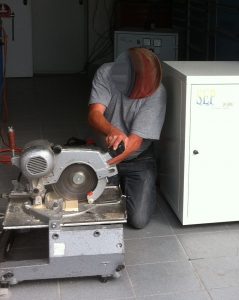
table saw
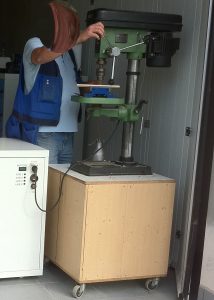
drilling machine
How much electricity consume household appliances?
Guidelines at a glance (data per hour):
Lamps: 50 watts
Laptop: 80 watts
Refrigerator: 120 watts
Freezer: 150 watt
TV flat screen: 150 watt
PC: 250 watts
Hood: 500 watt
Microwave: 800 watts
Hair dryer: 2,000 watt
Water cooker: 2.200 watts
Washing machine: 2,300 watts
Vacuum cleaner: 2,400 watts
Dryers: 3,000 watts
Dishwasher: 3.000 watts
Stove: 4,000 watts
Examples:
A hair dryer with 2,000 watts, which is used daily for 5 minutes, consumes 166 watts.
The flat screen TV with 150 watts, which runs 2 hours a day, consumes 300 watts.
A 4,000-watt cooker, which is used every half an hour, consumes 2,000 watts.
Durchschnittlicher KW-Verbrauch in Deutschland


